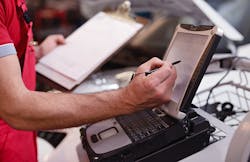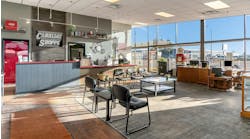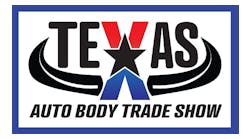Michael Giarrizzo calls them “the inefficiencies of the days of yore.” Ordering auto parts by fax machine, for example, or, even worse, making phone calls that require extremely detailed descriptions.
“It was all verbal communication with the vendor, trying to describe what you needed,” he says. “And hoping that the description was complete enough to get the correct part.”
These days, Giarrizzo is the president of DCR Systems, a company that helps manage body shops for six dealership groups, largely in the eastern U.S. And, lets just say he’s appreciative of new technology like electronic parts procurement systems, which help facilitate the ordering, tracking, and delivery of parts, lending supreme accuracy to dealerships.
“Their new developments of real-time feedback on the price matching … are a huge advantage,” Giarrizzo says.
Giarrizzo, whose 13-year-old company is poised to expand its reach in the near future, explains how the electronic parts ordering process can add efficiency and increase profits for dealership body shops.
What are some underrated ways body shops can use a parts procurement system to boost efficiency?
Whether you’re on a direct repair program or not, but especially if you are, some of these systems or applications really become part of your tools to help process those claims. First and foremost, they’re there for accuracy, ordering right, and then receiving correctly. Having an order that’s incomplete, or incorrect, or receiving a damaged part, that’s what wreaks havoc in an organization. That’s what creates the disappointing calls to the customer that say, “We expected these parts in today, but we’re missing this or this, so we’re going to be delayed.” It’s something that helps tremendously in terms of predictability, and predictability translating into a satisfied customer, because we’re able to constantly tell them and update them through the status of repairs.
And how can a body shop use an electronic parts ordering system to boost profitability?
One thing is for sure: adding the accuracy is going to boost profitability just from the standpoint that you’re reducing wasted effort. It may not be as vivid and clear, but when you look at the big picture, if you’re reducing unnecessary, redundant activity like reordering once or twice—or more—that’s a positive. From a profitability standpoint, it depends on where your philosophy as a collision center is when it comes to the type of parts usage. With our locations, we’re about original equipment. So, those electronic systems allow us to get to a palatable price quickly.
How can a shop get its employees quickly up to speed when trying to learn a parts procurement system?
We go through a number of stages. We have some video training. But, when it comes to stuff like this, vendor training is valuable, where somebody’s actually showing them the program, how to navigate through it, the ins and the outs. And then it’s really repetition—doing it over and over again, until it becomes second nature—and then adaptability to change.
Can using an electronic parts ordering system boost a body shop’s customer service?
Well, with parts procurement, it’s about predictability. Because of the way the system works in putting in an order, you have an increase in accuracy. You get back an estimated time of delivery for parts, and it makes the whole process become more predictable and dependable. When we know we’re going to have the parts and we have a high degree of confidence that they’re going to be correct, it allows us to talk confidently to the vehicle owner, as far as when they can expect the vehicle back, which is what’s important, so we can make good on that promise.



